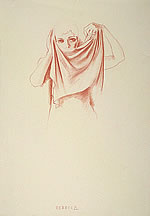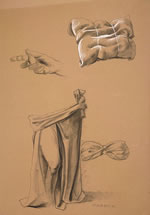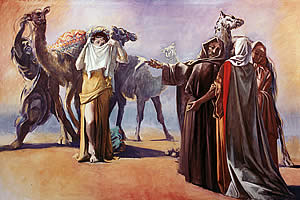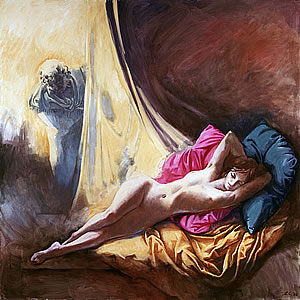| |
|
|
 |
|
| Reflections on the Women of the Bible |
|
|
|
|
|
|
| |
|
|
|
|
|
|
|
|
|
|
| |
|
From the writings which accompanied
the conception, completion and the public presentations of the
twelve Women of the Bible, Ernani Costantini collected some passages
from the Holy Scriptures and other texts in a folder,
along with his own personal reflections, from his preparations
for the fulfilment of this pictorial
cycle. For each character the painter has provided his own suggestions.
A selection of passages are included,
about the first and the last women in the cycle and about two of
the other ten, which help us to enter the mood of human, cultural
and religious reflection which drove and guided the artist in his
work. |
|
|
| |
|
|
|
|
|
|
|
|
|
|
| |
|
|
|
|
|
|
|
|
|
|
| |
|
|
|
|
|
|
|
|
|
|
| |
|
|
|
|
|
|
|
|
|
|
| |
|
|
|
|
|
|
|
|
|
|
| |
|
|
|
|
|
|
|
|
|
|
 |
 |
 |
 |
 |
 |
 |
 |
 |
 |
 |
 |
 |
 |
 |
 |
 |
 |
 |
 |
 |
 |
| |
|
|
|
|
|
|
|
|
|
|
| |
|
Rebekah |
|
|
|
|
|
|
|
|
| |
|
|
|
|
|
|
|
|
|
|
| |
|
|
|
|
|
|
|
|
|
|
“And Rebekah looked up, and when
she saw Isaac, she slipped quickly from the camel, and said to the
servant, – Who is the man over there, walking in the field
to meet us? – The servant said, – It is my master. – So
she took her veil and covered herself. ”
Genesis 24:64-65 |
|
|
|
 |
|
Study for Rebekah |
| |
|
|
|
|
 |
|
Study for Rebekah |
 |
 |
 |
 |
 |
|
| |
|
|
|
|
|
| |
|
|
|
|
|
| |
|
[…] I knew her. She sprang out
at me, alive from the Book, the vivacious girl who quenched the thirst
of my camels weary from their desert crossing. She ran from the
well to the waterhole, looking at me with her dark eyes, laughing
happily.
It was evening time when I gave her the golden nose ring; but
she accepted it and also the other gifts, reassuring me as she
ran ahead of me towards her father's house.
It was only later, when she saw Isaac, that she seemed to go pale
under the veil she had drawn across her face leaving only her eyes
visible which seemed to become even darker […] [E.C.] |
|
| |
|
|
|
|
|
| |
|
|
|
|
|
[…] Rebecca,
oh meek, I never rmeet you!
Just an handful of centuries divides us,
the twinkling of an eye, for whom who understand your lesson.
Only the divine is utter in the sip and in the crumb.
Only death overcomes him, if asking for full portion, […]
(Eugenio Montale – from Satura) |
|
| |
|
|
|
|
|
|
|
|
|
|
| |
|
|
|
|
|
|
|
|
|
|
Rebekah,
1984 |
|
 |
|
|
|
|
|
|
| |
|
|
|
|
|
|
|
|
|
|
| |
|
|
|
|
|
|
|
|
|
|
| |
|
|
|
|
|
|
|
|
|
|
| |
|
|
|
|
|
|
|
|
|
|
 |
 |
 |
 |
 |
 |
 |
 |
 |
 |
 |
 |
 |
 |
 |
 |
 |
 |
 |
 |
 |
 |
| |
|
|
|
|
|
|
|
|
|
|
| |
|
Shulammite |
|
|
|
|
|
|
|
|
| |
|
|
|
|
|
|
|
|
|
|
| |
|
|
|
|
|
|
|
|
|
|
[…] The voice of my beloved!
Look, he
comes, […]
Look, there he stands
behind our wall,
gazing in at the windows,
looking through the lattice.
My beloved speaks and says to me:
'Arise, my love, my fair one,
and come away'; […]
(Sog of Solomon 2:8-10 ) |
|
|
|
 |
| |
| Shulammite, 1984 |
|
| |
|
|
|
|
|
| |
|
|
|
|
|
| |
|
Almost four years have passed since I
was tempted by the love song of Sulamita and her loved one. And now
more than then – maybe because I have had to explore that theme – I
feel I have understood the enormity and the beauty of this absolute
love, disarming and (deep down) ingenuous and pure.
A love beyond every request which does not regard the
pulses of the heart and the imagination; which associates us with
more beautiful things, better things, more gracious and eager, the
loved one. And love makes us dream like something complete […]
the love which becomes the nature of a poet’s soul for a total
and absolute happiness.
[E.C.] |
|
| |
|
|
|
|
|
|
|
|
| |
|
|
|
|
|
|
|
|
|
|
At the
evening of life, we shall be judged on love
(St. John of the Cross) |
|
|
|
|
|
|
| |
|
|
|
|
|
|
|
|
|
|
| |
|
|
|
|
|
|
|
|
|
|
| |
|
|
|
|
|
|
|
|
|
|
| |
|
|
|
|
|
|
|
|
|
|
 |
 |
 |
 |
 |
 |
 |
 |
 |
 |
 |
|

